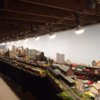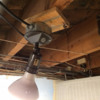Well, this thread finally got me to jump in and change out my hodgepodge of fluorescent fixtures in the train room with LEDs.
A few facts about my decision and about the bulbs themselves.
- I decided to scrap the old, mostly shop light quality fixtures entirely and go with banks of LED floodlights.
- I was not going for energy savings as much as the lower wattage which allowed more bulbs on each circuit.
- I chose bulbs with a 3000K rating. 2700K is too warm and 5000K too blue for my tastes, and for the photography I do.
- About the floodlights I used. I chose BR rated bulbs which give a wide coverage. The PAR series are spotlights with more intense light over a smaller area. The PARs are good for highlighting certain areas, but, for my photography, I prefer the even illumination of BRs.
- I ended up using BR40 17 W (100W equivalent) bulbs spaced about 32" apart (every other joist) for my 30" wide around the walls layout.
- To cut costs I used inexpensive outdoor style floodlight fixtures. My basement is unfinished and everything will be hidden behind a valance so appearance was not a factor.
- Best money I've spent on the train room! Now I flip a switch and instant light - no more flickering to life and no more buzzes or hums. I didn't realize how noisy all those fluorescent fixtures had been!
Thanks to all who posted here for giving me the push to finally do this.
A couple of quick photos of one side of the layout before the valances were re-installed and before general room lighting was added. Many more photos to come!
Jim











